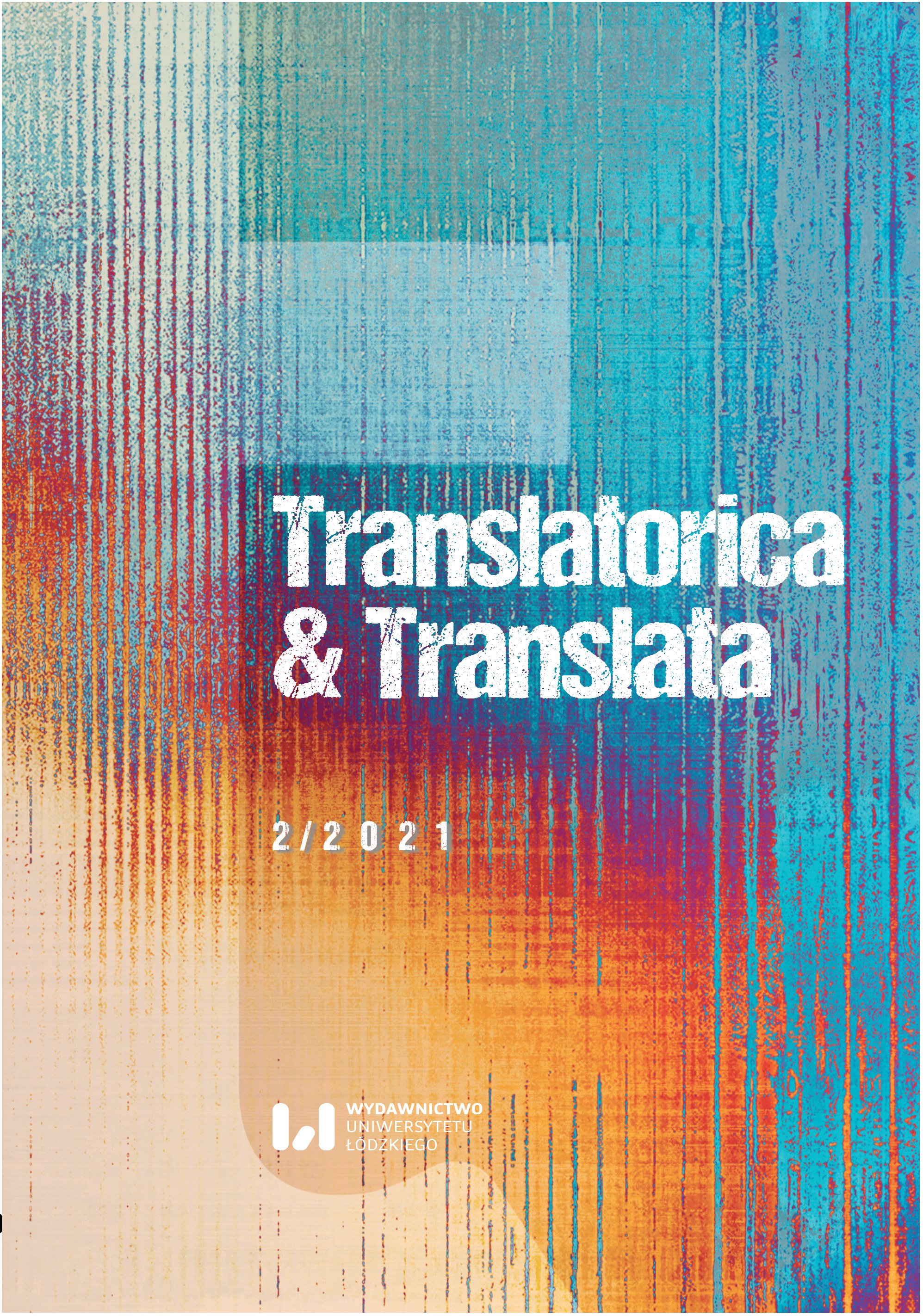(Un)translatability of literary texts. The names of the protagonists of "Obywatel męczennik" written by Tomasz Kaczmarek in Italian translation
DOI:
https://doi.org/10.18778/2544-9796.02.01Keywords:
untranslatability, equivalence, equivalent, source text, meaning, polysemy, semantic field, adequacyAbstract
The paper presents the key concepts in Translation Studies such as untranslatability and equivalence. The author seeks to gain an insight into the theories relevant for translation and their development especially in the field of literary translation. To translate means to understand and explore the unique and extraordinary world created by the author in order to be able to reproduce it in another language and to evoke similar reactions, emotions and reflections.
References
Antończyk, W. & Panasiuk, A. (1998). Traduttore di fronte al suo lavoro. In: K. Wojtynek, Traduttore non sempre traditore. Problemi di traduttologia emersi a partire dalle traduzioni in polacco di alcune opere della narrativa italiana. pp. 9–19. Katowice: Wydawnictwo Uniwersytetu Śląskiego.
Google Scholar
Austin, J.L. (1962). How to do things with words. London: Oxford Univeristy Press.
Google Scholar
Baggio, M. (1984). La traduzione nelle teorie linguistiche contemporanee. In: La traduzione nell’insegnamento delle Lingue Straniere, pp. 7–30. Brescia: Universita cattolica di Brescia.
Google Scholar
Bassnett, S. (1993). La Traduzione. Teorie e Pratica. Milano: Strumenti Bompiani.
Google Scholar
Bertozzi, R. (1999). Equivalenza e saper traduttivo. Milano: LED. Edizioni Universitarie di Lettere Economia Diritto.
Google Scholar
Bühler, K. (1934). Sprachteorie. Die Darstellungsfunktion der Sprache. Trad. it di Serena Cattaruzza Derossi. (1983). Teoria del Linguaggio. pp. 76–85. Roma: Armando Editore.
Google Scholar
Cigada, S. (1988). I meccanismi del senso: il culminatore semantico. In: E. Rigotti & C. Cipolli (a cura di), Ricerche di semantica testuale. pp. 1–70. Brescia: La Scuola.
Google Scholar
Delisle, J. (1998). Translation: an Interpretive Approach. Ottawa: University of Ottawa Press.
Google Scholar
Eco, U. (2010). Dire quasi la stessa cosa. Milano: Bompiani.
Google Scholar
Głowiński, M. (1969). [Wstęp do:] Julian Tuwim. Wiersze wybrane. pp. III–LXVIII. Wrocław: Ossolineum.
Google Scholar
Halliday, M.A.K. (1992). Language Theory and Translation Practice. Rivista internazionale di tecnica della traduzione. pp. 15–25.
Google Scholar
Jakobson, R. (1966). Aspetti linguistici della traduzione. In: R. Jakobson, Saggi di linguistica generale. pp. 56–64. Milano: Feltrinelli.
Google Scholar
Jakobson, R. (1989). W poszukiwaniu istoty języka. T. 1. Warszawa: PIW.
Google Scholar
Lipiński, K. (2004). Mity przekładoznawstwa. Kraków: Wydawnictwo Egis.
Google Scholar
Menin, R. (1996). Teoria della traduzione e linguistica testuale. Milano: Edizioni Angelo Guerini e Associati SpA.
Google Scholar
Newmark, P. (1969). Some notes on translation and translators. Incorporated Linguist 8 (4). pp. 79–85.
Google Scholar
Newmark, P. (1988). Approaches to Translation. Hertfordshire: Prentice Hall International (UK) Ltd.
Google Scholar
Nida, E. (1964). Toward a Science of Translating with Special Reference to Principles and Procedures Involved in Bible Translating. Leiden: E.J. Brill.
Google Scholar
DOI: https://doi.org/10.1163/9789004495746
Nida, E. (2010). Principi di traduzione esemplificati dalla traduzione della Bibbia. In: S. Nergaard (2010). Teorie contemporanee della traduzione. Testi di Jakobson, Levý, Lotman, Toury, Eco, Nida, Zohar, Holmes, Meschonnic, Paz, Quine, Gadamer, Derrida. Milano: Strumenti Bompiani.
Google Scholar
Nida, E. & Taber, Ch. (1969). The Theory and Practice of Translation. Leiden: J.E. Brill.
Google Scholar
Sapir, E. (1921). Language: An Introduction to the Study of Speech. New York: Harcourt Brace.
Google Scholar
Sapir, E. (1972). Cultura, linguaggio, personalita. Torino: Einaudi.
Google Scholar
Searle, J.R. (1969) Speech Acts. UK: Cambridge University Press.
Google Scholar
DOI: https://doi.org/10.1017/CBO9781139173438
Teubert, W. (2004). Language and corpus linguistics. In: M.A.K. Halliday, A. Cermáková, W. Teubert & C. Yallop. Perspectives in Lexicology and Corpus Linguistics. pp. 73–112. London: Continuum.
Google Scholar
Tęcza, Z. (1997). Das Wortspiel in der Übersetzung. Stanisław Lems Spiele mit dem Wort als Gegenstand interlingualen Transfers. Tübingen.
Google Scholar
DOI: https://doi.org/10.1515/9783110959963
Van Dijk, T.A. (1980). Testo e contesto. Bologna: Universita di Bologna.
Google Scholar
Von Humboldt, W. (1836). The Heterogeneity of Language and its Influence on the Intellectual Development of Mankind. New edition: On Language. On the Diversity of Human Language Construction and Its Influence on the Mental Development of the Human Species. Cambridge University Press, 2nd rev. edition 1999.
Google Scholar
Weisgerber, L. (1964). Zur Grundlegung der ganzheitlichen Sprachauffassung. Aufsätze 1925–1933, ed. by Helmut Gipper. Düsseldorf: Pädagogischer Verlag Schwann.
Google Scholar
Whorf, B.L. (1956). Language, thought and reality. United States of America: MIT Press.
Google Scholar
Kaczmarek, T. (2013). Obywatel Męczennik. In: “Karp po żydowsku” i inne sztuki teatralne. Pruszków k. Łasku: Oficyna Wydawnicza LEKSEM.
Google Scholar
Tuwim, J. (2003). La locomotiva, trad. M. Woźniak. Kraków: Instytut Adama Mickiewicza.
Google Scholar
Downloads
Published
How to Cite
Issue
Section
License
Copyright (c) 2021 Translatorica & Translata

This work is licensed under a Creative Commons Attribution-NonCommercial-NoDerivatives 4.0 International License.








